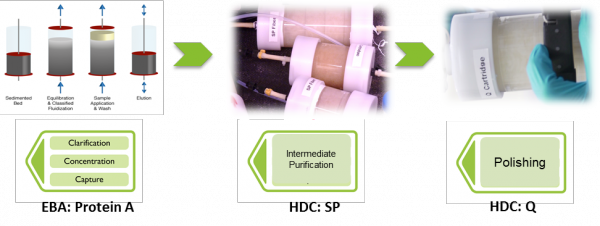Hector Fernandez-Lahore Keynote

Unconventional Chromatography for MAB Recovery and Purification
The INTENSO Monoclonal Antibodies Purification Platform utilizes different types of expanded bed formats -from product capture to intermediate purification to polishing. The main advantage of expanded bed systems is an increased voidage that allows for direct protein recovery from a crude feedstock. Moreover, efficient mass transfer and moderate operating pressures are maintained during chromatography. The INTENSO mAb purification platform introduced two types of “expanded” adsorbents a) Fluidized / classified bed of biofouling-resilient particles for primary recovery (EBA) and b) Cartridge-encased fibrous adsorbent networks for intermediate purification and polishing (HDC) (Figure 1).

Figure 1: INTENSO mAb purification platform
The first stage of our work involved the development and optimization of process conditions for initial product capture employing fluidized beads. These are normally prone to biomass adhesion –that causes deteriorated bed hydrodynamics and increased mass transfer limitations. This, in turn is responsible for limited process performance. A “biofouling-resilient” adsorbent was introduced via polymer coating. To understand biomass interaction with process surfaces, an energetics approach was utilized. Nineteen different polymers were studied as “antifouling” agents. Three polymers were chosen for further studies: Polyacrylic acid (PAA), Poly(methacrylic acid) (PMA), and Poly(vinyl sulfate) (PVS). Screening experiments were validated with Protein A adsorbent beads, coated with 0.1% polymer solution. Sorption experiments were conducted at laboratory and sub-pilot scale. Polymer coating did not alter mAb binding but enhanced product recovery in the presence of CHO cells. For example, coating with PMA significantly enhanced binding capacity up to 50% in the presence of cells while PAA increased mAb binding capacity up to 20%.
In a second stage, process integration of BR-EBA with HDC (another type of “expanded” adsorbent) was introduced. HDC is a hybrid approach created by merging existing textile technology with material chemistry so as to generate a cost-effective (and disposable) system supporting eco-friendly bioprocessing. In this study, HDC were functionalised with SP and Q ligands. Process integration resulted in 75% of total recovery of mAb with 96% of purity after the polishing stage, whereas standard mAb purification procedure will result in 69% of total mAb recovery after polishing stage. Furthermore, the platform also yielded a final product comply with residual DNA and HCP, and aggregate level as per industry benchmark.
Summarizing, novel approaches to chromatography have potential for the streamlined recovery and purification of bioproducts.

